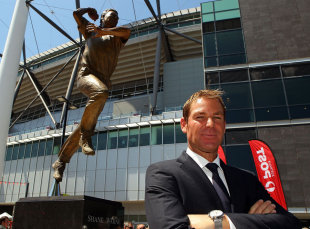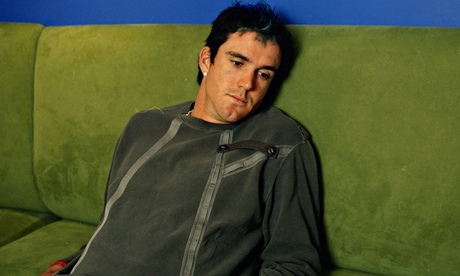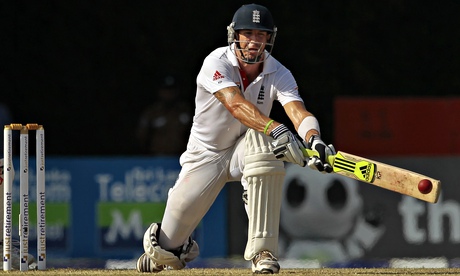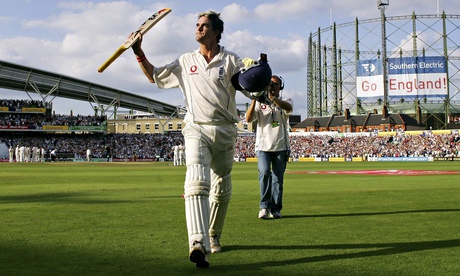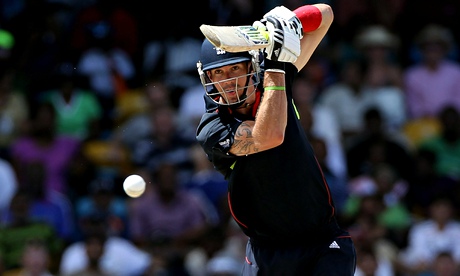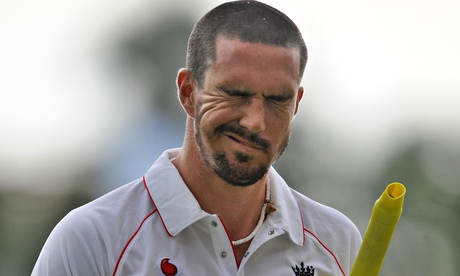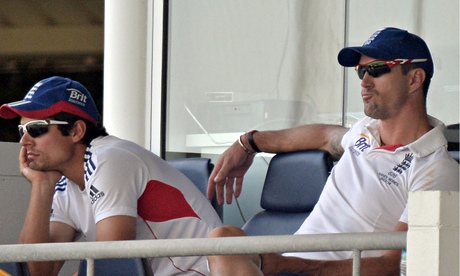I know, I know. We’ve done the KP thing to death now. But we simply had to publish this very insightful article by Tregaskis. It takes a broad perspective and frames events somewhat differently to the norm. If only more mainstream cricket journalists had taken a similar approach ….
I recall attending a conference a few years back when the guest speaker opened with an old joke – “Asked how many people worked in his organisation, a CEO replied “about half of them.” The conference was about motivation and engagement in the workplace, and Paul Downton’s interventions on the subject during the unveiling of Peter Moores as the England cricket head coach struck me as something that deserved a second look.
Downton said there were no specific issues surrounding Pietersen’s sacking – “I arrived in Sydney on 31 December and it was clear from Andy Flower that there were two issues we were facing. He [Flower] was uncertain about his future – and what were we going to do about Kevin? … I watched every ball of [the fifth Test in] Sydney, and I have never seen anyone so disengaged from what was going on. What you need from a senior player is backing and support and everybody working together, but we had got to a stage where that was no longer the case.”
With a mounting cast of injured, retired and disaffected players, Downton’s demand for the backing and support of Pietersen raised a rather awkward question – what kind of backing and support does the ECB gives its players? In balancing the pursuit of financial gain and the well-being of its players, where is the ECB positioned – Primark sweatshop or John Lewis Partnership. How does its record on connectivity stack up?
It is a truth universally acknowledged that an organisation lacking effective leadership will experience an endless stream of crises, problems and dropped balls. An analogy is sometimes made to turtle farmers, who buy the baby reptiles and put them in small tanks. The turtles stop growing in response to the limited living space. All the potential for growth is stunted. It is the same in command-and-control hierarchies like the ECB, especially ones headed by a Hippo, where the Highest Paid Person’s Opinion overrides creative input in favour of gut feeling, pride and prejudice.
Enlightened organizations understand that if they are to retain talent and optimise performance, they need to engage with their workforce. Leadership is not about demanding connectivity but creating an environment in which employees can thrive. The best organisations do not see their employees simply as interchangeable cogs in a mechanism for delivering a product or service. They see them as the most important assets of the business; the best may even be a million-dollar asset.
General Norman Schwarzkopf, of Gulf War fame, knew a thing or two about leadership. He said: “I have seen competent leaders who stood in front of a platoon and all they saw was a platoon. But great leaders stand in front of a platoon and see it as 44 individuals, each of whom has aspirations, each of whom wants to live, each of whom wants to do good.”
Russell Jackson, in the Guardian the other day, describes the job done by Darren Lehmann in transforming a dud and dysfunctional Australian team by “creating the environment in which this collection of players could thrive as individuals, take pleasure in each other’s performance and quickly turn themselves into such a dominant outfit.”
There are countless measures for assessing whether a business is engaging with its employees. For instance, does management show it values its employees? Is an employee’s input shown to be important? Do employees feel free to voice their ideas and opinions? Are leaders as quick to praise an accomplishment as they are to criticize a failing? Is the employee’s position secure? So how does the ECB measure up as an enlightened employer?
The list of recent players feeling badly treated by ECB management includes Nick Compton, Michael Carberry, Monty Panesar, Jonny Bairstow, Steven Finn and Kevin Pietersen. I don’t suppose Ashley Giles is feeling particularly well valued at the moment. That is the spine of a pretty decent-looking England test team. As Mike Selvey might have said in a parallel universe, with this many disaffected players around, something must be wrong with the way they are treated.
Kevin Pietersen is a high-profile victim of the ECB command-and-control regime. His is a complex case study because he is both the most successful England batter of his generation and also one of its most neurotically demanding. Pietersen is hard wired to seek achievement and perfection alongside recognition and affection. These are personal and emotional goals that drive most professional cricketers, but in Pietersen’s case they are magnified exponentially because of his brilliance and particular psychological needs.
Disengagement is a recognised coping mechanism displayed by people suffering anxiety through, say, feeling unsafe, unloved, and undervalued. Steven Pye in his Guardian blog on the 1981 Ashes series observed that the concept of Botham being on trial was not helped when he was made test captain on a match-by-match basis only. It was, wrote Pye, far from ideal and unlikely to improve Botham’s ailing form with that amount of tension hanging over him.
Botham was a beast every bit as big as Pietersen, yet he crumbled under the pressure, till rescued by the man-management skills of Mike Brearley. Downton should know – he played in the first 1981 test! Pietersen has been on trial for half his international career; how safe can he have felt? He had to keep his head down. If he had looked up he would have been stabbed in the eye by the sword of Damocles poised perpetually and perilously above him.
Type “Pietersen, unloved” into Google and endless headlines come up like this from the Telegraph in 2010 – “Unloved Cricketer Kevin Pietersen blah blah” and this from the Mail in 2014 – “Gifted but Unloved KP Never Belonged.” Being Kevin Pietersen can’t have been easy in a press environment that targeted him with years of personal antipathy. His wealth, flamboyance and outward self-belief marked him not as a talented and successful individual but as unclubable. He was a marked man whose failures were always embraced with more joy than his successes.
The Pietersen charge sheet lists three principal felonies. First, his removal of Moores (#1) as head coach; secondly, text-gate; thirdly, his disengagement during the Sydney test. On each of these occasions, it can be argued that Pietersen was simply exhibiting recognised behaviour patterns commonly seen in victims of stress-ridden, high-anxiety, alienating environments.
Going back five years or so, it was clear that Moores (#1) did not possess the competence to bridge the gap between county and international cricket. He was unable to connect with senior professionals and failed to progress the team in terms of meaningful results. Michael Vaughan has described how Peter Moores operated first time around – “The team is starting to get irritated by the new management regime – being told what to do and treated like school kids. Peter loves talking and having the last word.”
Vaughan gives as an example an occasion when the team was asked to write down “100 things” that would improve the team. This tripe comes from the same coaching-by-numbers manual employed by Mickey Arthur, the Aussie head coach to be forever remembered as the architect of homework-gate. By all accounts, the headmasterish Andy Flower was more Alcock than Powlett-Jones, more Chief Superintendent Bright than Endeavour Morse. His prescriptive, micro-managing style offered little room for players to voice ideas or opinions of their own, and extended little forgiveness to those that did. The turtle tank was a small, growth-retarding environment under both Moores (#1) and Flower.
This was never just a Pietersen-Moores conflict. Vaughan, Strauss and Collingwood all doubted Moores and his methods. Pietersen, in circumstances not dissimilar to the dressing-room meeting some five years later, was invited to present his strategy for improving England’s performances and in a showdown with Giles Clarke made it clear that his vision for improvement did not include Moores. Pietersen may or may not have given a him-or-me ultimatum but the conflict was leaked to the press. Dennis Amiss, vice-chairman of the ECB, confirmed that Pietersen was not responsible for the leak, though the leak pretty much ensured the matter could not be resolved behind closed doors. It could only have come from within the ECB.
Pietersen’s position was not unexpected or unreasonable. That is why Moores was sacked. Moores’s incompetency was not Pietersen’s fault. Pietersen resigned before he was sacked himself, but his departure flowed not from inappropriate behaviour towards Moores (#1), but because the ECB felt uncomfortable with investing this captain with so much power. Fast-forward five years and the ECB’s decision-making is now built around supporting the captain regardless of his faultlines. Cook is arguably the worst but most powerful captain in a generation. It is hard to see any consistency in the ECB’s ethical baseline.
Pietersen’s tactical mistake was seeking to have Flowers removed as batting coach at the same time. He did so, presumably, because Moores (#1) and Flowers were close and shared a common coaching philosophy. In those terms, it made sense for the ECB to let both coaches go and appoint someone with a completely different approach to player motivation. The appointment of Flower as head coach will, for Pietersen, have been a hammer blow and the worse of all possible scenarios.
A series defeat to India in winter 2008 triggered the tumultuous double sacking. Over the next three and a half years, Pietersen must have incubated a deep and growing distrust of the ECB. His unfair dismissal as captain, the embarrassing return to the ranks, the devious leak, the regular fines over innocuous Tweets. He was poorly treated, undervalued and picked on for meaningless misdemeanours. Flower’s appointment as head coach will have done nothing to quell Pietersen’s neurotic tendencies and by all accounts the two men made do with a distant relationship that was awkward and good-times dependent.
Flower comes across as a manager long on memory and short on forgiveness, and Pietersen would have been justified in thinking that revenge when it came would be a rasgoola over a vindaloo. While Pietersen’s ashes were not exactly released into the Ganges, January 2009 marked the moment when the ECB first set Pietersen adrift. Even so, Andrew Strauss confessed that he admired how graciously Pietersen behaved, in impossible circumstances, towards management, the players and to Strauss himself as the new captain. Pietersen continued to make an MVP contribution to England’s elevation to No 1 test team in the world.
This was the context in which the hokey-cokey central contract discussions were taking place, with Pietersen wanting to play in the IPL, his natural milieu, and the ECB telling him his contract said no. So Pietersen decided to retire from ODIs, to concentrate on tests and T20, but the ECB again said no. It was an inflexible no, a prescriptive no, a no with knobs on. Every other player in the world of Pietersen’s considerable calibre was playing in the IPL. A cricketer has a short career and needs to make the most of his earning power. The international stars of world cricket apart, it was hardly fair that players like Napier, Mascarenhas, Shah and Bopara could earn big bucks in India while exponentially better players on central contracts could not.
There were tectonic forces at play here, between a command-and-control behemoth and the evolution of the cricketing market. Suddenly, natural selection had become an indefinable concept. It may play out badly again this season if Morgan fails to make the test team after “choosing” to showcase his skills in a damp and cold English April instead of the warmth of a dollar-rich six weeks in India.
Meanwhile, in the dressing room, Pietersen caught wind of a parody Twitter account called KP Genius set up by a wag, who turned out to be a mate of Stuart Broad. The tweets set out to ridicule Pietersen and his perceived ego and hubris. There were a number of followers in the team and Pietersen believed that the tweets were being fed by leaks from the England camp. At a time when Pietersen felt that he was being straitjacketed by the ECB negotiators, the KP Genius shenanigans must have removed any refuge he thought he had in the dressing room. The press largely laughed this off as a light-hearted jape that pricked the thin skin of the resident diva.
Andrew Strauss tells us that Pietersen’s in-out-shake-it-all-about negotiations meant he had major bridge building to do with his teammates, without ever explaining why. This was a hostile environment in which Pietersen was required to go about his work. He was being alienated inside and outside the dressing room, with unsympathetic noises off from the press. Yet while Strauss’s man-management skills were in sleep mode, and the ECB were micro-managing his life, Pietersen went about his day job scoring 149 in the second test against South Africa in one of his most audacious knocks ever.
With cricket known as the divorce sport, it did not need Pamela Stephenson Connolly to point out that a high performing talent alienated in his work environment may well seek friendship and approbation elsewhere. It was, after all, a loveless marriage. Pietersen chose de Villiers and Steyn, both IPL teammates, as his tit-bits on the side. Pietersen got it wrong. It was inappropriate, insensitive and dumb. He should have exercised more self-discipline. But this was to ask him to rise above the provocation and disconnecting tendencies of the ECB and the dressing room.
His actions were professionally unforgivable but emotionally understandable. This was an employee, treated badly by management, having a big moan around the water cooler. There has never been a proper debate about the proportionality of the ECB’s response to Pietersen’s texts. Like the 50 misdemeanours, they have never been published, so they could be something or nothing. At a guess, barely three people in the world knew the content, but there was a great deal of spinning against Pietersen. Sub-editors crafted headlines and journalists pursued a narrative based on threadbare facts that fed an agenda.
Fast-forward two years and the ECB continues to spin a miserable line of empty cares and empty fables. Andrew Strauss has accepted that he does not think Pietersen tipped the wink on the skipper’s batting frailties. Pietersen was a victim of another leak, and once again this prevented the matter being handled behind closed doors. The press seized on the matter with rather less hilarity than it did the KP Genius affair. Strauss was hurt, distraught, let down. Not emotions permitted to Pietersen.
What followed was the most pernicious phase in the ECB’s dismantling of Kevin Pietersen’s career. Text-gate was spun to a frenzy. Pietersen had to publicly mea hisculpa before a schadenfreude press, self-flagellate before Matins, prostrate himself before a system that wanted to bring him down a peg or four. This was not a seamless rejoining with the team in the way Shane Watson and Mitchell Johnson took up their natural place in the Australian team after homework-gate. This was an ugly re-integration with Frankenstein stitching. It was a pejorative “re-integration” tattooed on the miscreant’s forehead in indelible glow-in-the-dark ink. This was three strikes and you are out. This was Flower’s cold-hearted revenge.
From this point, Pietersen’s locker was redesigned to feature a naughty step. It appears disproportionate and a further mismanagement of a key asset. It would have been easier and more financially beneficial for Pietersen to have thrown in the towel and exchanged his flannels for the blue pajamas of the Dehli Daredevils he knew. Yet he swallowed his enormous pride and stayed. He wanted to play for England and had his eye on the 2015 Ashes and reaching 10,000 runs.
It would have been better for the ECB to sack Pietersen and make a clean break. Its half-hearted decision to re-integrate him under probation-like terms simply widened an existing schism and reinforced the detached status of its star batter. So far removed was Pietersen from the heartbeat of the team, he would have needed a 50-foot stethoscope to detect its pulse.
Over the course of the winter, as a buoyant Australia dismantled England like Chittagong ship breakers, the hidden fractures and stress points in the England cricketing vessel were brutally exposed. Faultlines in management and leadership were revealed as success fell away, and these led to the two key incidents that finally did for Pietersen.
First up was the infamous team meeting held at the tail end of the Melbourne test. The team had lost the first four tests with no strategy for arresting a slide into 2006-like ignominy. The most common understanding is that captain Cook and vice-captain Prior called the meeting in an attempt to wrest responsibility for the team away from a suffocating management and back to the players. Flower, Gooch and Saker were out of this loop. The agenda must have written itself – how does the team salvage some pride from the wreckage? The terms of reference were written in the blood of brothers – what was said in the dressing room stayed in the dressing room.
Only it didn’t. The loop turned out to be a Möbius strip with Flower not informed and totally informed both at the same time. In a reprise of events in 2009, Pietersen was asked for his input and gave it. Never shy, given a platform to express his views, these were likely brutal, on the nail and lacking in diplomacy.
I doubt his thoughts on Flower had changed that much over five years, any more than Flower’s thoughts had adjusted to Pietersen’s non-conformity and hubris. Hell, the team was in crisis, he was a senior professional and he was asked. I wonder how much pent-up frustration and resentment spilled out during the few minutes that he held the conch?
It turned out that the sanctity of the dressing room was as semi-permeable as the current confidentiality agreement. Someone betrayed Pietersen to Flower, who seemed more concerned with Pietersen for his unreconstructed views than with Cook for holding a secret meeting. Clearly the captain and vice-captain thought the team was disconnected from management in some critical degree. Pietersen did not call the meeting. He had no power to enforce his views. His was one of maybe two dozen opinions. If he carried the meeting, then he had a point. If he didn’t, then what was the problem? According to Tremlett, he was just honest.
When the ECB’s Orwellian Ministry of Truth justifies Pietersen’s exclusion on the grounds of trust, those outside its totalitarian regime might just marvel at how may times Pietersen has been leaked against, ridiculed, betrayed, humiliated and alienated over the past half dozen years by those in a leadership role. His tormentors have been aided by a compliant, embedded press, including a cabal of former low-to-mid ranking test bowlers, drunk on their proximity to power and privilege. These have lickspittled and polished the ECB’s tampered narrative and undermined the character of the South-African-born Pietersen, as they prefer to call him.
The second incident was probably fairly innocuous but for being unhappily adjacent to the first. Two days before the final test, Cook decided that the best strategy in the face of Ashes annihilation was to concentrate on fitness levels. Pietersen argued that the time would be better spent focused on sharpening skills in the nets. Cook was so on the wrong side of the argument that it barely deserves analysis. A day of bleep tests and squat thrusts would do diddly squat for fitness levels in a test match just 48 hours away, but it definitely risked player fatigue and stiffness. It was no more a fix than singing a happy song when your parachute fails to open. It might take your mind off the problem for a while, but it would not stop you hurtling towards oblivion. I doubt Pietersen was any more impressed that his attempts to manage a dodgy knee were being compromised by Cook’s desperate embrace of his mentor’s obsessive work ethic.
It has been reported that Flower observed the exchange and called Pietersen into his study and admonished him for questioning the captain and for the views he expressed in the players’ meeting. Whether or not Flower used the occasion specifically to call time on Pietersen’s future in the team, Pietersen must have known that the gossamer thread that held the sword of Damocles precariously at bay was about to be cut. Flower crushed Pietersen’s hopes of clinging to the wreckage by indicting him with a third strike. In these circumstances, it would have required ninja turtle fortitude to avoid an overwhelming emotional disassociation from the dementors who had sucked all happiness from him.
So when Pietersen walked to the crease for the second time during the fifth and final test in Sydney he must have known that short of scoring a match-winning 300, nothing would prevent his walk back to the pavilion from being the last time he would wear an England shirt. Caught Bailey bowled Harris for three was not a career-rescuing performance.
Whistling a happy tune in the dressing room, far from being an expression of disinterest, was a classic way of coping with the stress and anxiety brought about by the situation. This was not just the shoulder-dropping, hip-holding, foot-staring, head-shaking, confidence-sapping, mind-scrambling dejection suffered by the rest of the team following the humiliation of an Ashes whitewash. For Pietersen, this was also the apotheosis of five years of ECB alienation – the end of his international career and the destruction of his legacy.
If the watching Paul Downton had never seen anyone so disengaged from what was going on, he should have been watching with a wider angled lens. Neither can he have been paying much attention when he played with Geoff Boycott. Nor can he have been in receptive mood as his captain, Mike Brearley, quietly went about his work as one of the great sports leaders of his generation. Imagine Alastair Cook trying to lead a team featuring Boycott and Botham!
The bubble in which England cricketers are confined is characterised by few of the markers that identify an enlightened and connecting working environment. There are other rather different markers at play. The relentless playing schedule leading to inevitable homesickness, burnout and career-ending injuries. Players taking to the field carrying niggles and half-healed strains, kept together with cortisone injections and vinegar and brown paper.
A work environment in which Jonathan Trott felt compelled to keep mum and carry on while the team doctor allowed the batter’s mental state to unravel before his eyes.
The philosophy of consistent selection, so successful during England’s upward trajectory, transitioned to a more random pick-and-drop policy, leaving in-and-out players confused, under-confident, undervalued and fearful of failure. It could be argued that over the winter, the entire team underwent a mental disintegration, but in spite of having a psychologist among the backroom staff, this was missed or most likely ignored. The word coming out of Lord’s is that Paul Downton intends downgrading the role of Mark Bawden, the team psychologist, which seems a backward step in terms of modern sports welfare.
There is a fascinating piece by Dylan Cleaver in the New Zealand Herald back in October 2013, so a few months before Jonathan Trott’s breakdown, exploring why cricket is widely known as the divorce (sometimes suicide) sport. Quoting Mike Brearley, he observes that cricket is an “uniquely dangerous environment … there are unique pressures associated with the sport that lead, not necessarily to suicidal thoughts and depression, but towards situations that require a reservoir of mental wellness to cope.”
There are big themes at play in the Pietersen story – loyalty and betrayal, truth and deception, justice and punishment, money and personal development, with a dramatis personae to match. But on the ECB’s central charge against Pietersen of disconnection and untrustworthiness, there is a compelling case for saying physician, heal thyself. In a sport where management should have a heightened responsibility to engage with its employees and look after their well-being, the ECB has shown itself to be inward looking, self-serving and ridden with sinecure appointments and insincere platitudes. It is more connected to its financial interests than the interests of its players. Over the past four months it has exhibited an arrogant disregard for large swathes of its fan base, dismissing lay supporters as outside cricket. Like Kevin Pietersen and others, we have all been disconnected.
With casualties in the aftermath of the worst tour in cricketing history confined to a couple of blokes who had least responsibility for it, and the ECB reinforcing its inbred cosiness in the shuffling of its management team, the appointment of Moores (#2) suggests there is little prospect of the turtles getting a bigger tank any time soon. In April 2007, Mike Brearley said the appointment of Moores (#1) smacked of favouritism. I’m afraid the 2014 appointment of Moores (#2) and retention of Cook smacks of turtle-ism.


